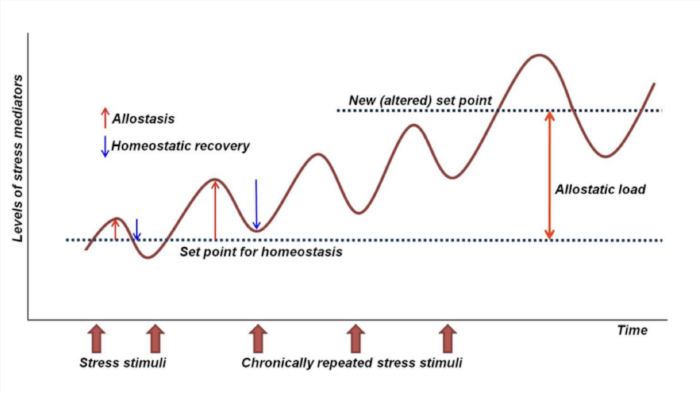The Price of Service: Allostatic Load + “Wear and Tear On The Body’
At Arena Labs, our work—and the power of our platform, Arena Strive—centers around three pillars: managing stress and load, maximizing recovery and sleep, and balancing energy. But all of these principles tie into a broader understanding of how stress impacts the human body.
In the last 30 years, advancements in science have profoundly shaped our understanding of stress and its effects, particularly on people in service-oriented fields. In the 1980s, Dr. Peter Sterling introduced the concept of allostasis—how the body grows and adapts through stress. When this adaptation is healthy, it fosters growth, sometimes referred to as “eustress.”
However, Sterling also wrote extensively about allostatic load—the wear and tear on the body from chronic stress. Thanks to modern technology, we now have a clearer picture of allostatic load, what it looks like, and its implications for individual health and well-being.
Let’s consider an example and use this visual to chart allostatic load:

Imagine a surgeon who entered medical school 20 years ago. At that time, her body had a physiological baseline: a resting heart rate of 55 beats per minute, an HRV (heart rate variability) of 70 milliseconds, and consistent, restorative sleep. Her sleep cycles likely included sufficient slow-wave (deep) sleep, followed by healthy REM stages.
But as she progressed through residency and into her career, the demands of her profession increased. She worked long nights, handled the stress of learning complex technical skills, and navigated the emotional toll of patient care. Over time, her body began to shift. She took vacations or weekends off here and there, but the recovery never fully returned her to her baseline.
Fast forward 20 years: her resting heart rate has crept up to 75 beats per minute, her HRV has dropped to 45 milliseconds, and her sleep is no longer consolidated. She struggles to fall asleep and often wakes up a few hours in, conditioned by years of pager interruptions and anticipatory stress.
This cumulative shift—her new “set point”—is allostatic load. And while it might seem like a natural consequence of a high-stress career, it’s not without significant costs. Allostatic load impacts not just physiology but also emotional well-being, cognition, and overall resilience.
The Price of Service
A growing body of literature points to the realities of allostatic load in service: those who are deeply driven by a mission to protect and care for others, often do so at their own expense. From first responders and teachers to military personnel and frontline healthcare teams, the propensity to give of oneself to a “bigger mission”, often comes at a cost over time.
While burnout is endemic in all parts of society, it is particularly acute in those professions where a “calling” makes the demands of the mission feel especially vital to save lives and to protect.
Healthcare, more so than any other field, suffers particularly from this school of thought. The “patient centric” aspects of training as a doctor or nurse all emphasize the critical nature of “patient quality”, “patient safety” and “patient experience”. This orientation on the external variable, over time, always comes at the expense of the clinicians who is serving everything but their own recovery, rest and regeneration.
The Opportunity for Change
Here’s the good news: the same advancements in technology that allow us to measure and understand allostatic load also reveal pathways to mitigate it.
What’s encouraging is that many of these solutions are accessible to anyone. They don’t require cutting-edge equipment—just intentional behavior change. For example:
- Improving Sleep: Learning how to fall asleep faster and stay asleep longer.
- Hydration: Understanding how hydration supports sleep quality and overall energy balance.
- Intentional Recovery: Using weekends or downtime to truly reset and prepare for the demands ahead.
At Arena Strive, our mission is twofold: first, to help people understand the realities of allostatic load, especially in high-stress industries like healthcare. And second, to give individuals a sense of agency—a roadmap of science-backed tools and techniques proven to reduce stress, enhance recovery, and restore balance.
This isn’t just a story of decline. It’s a story of potential. With the right knowledge and tools, we can help individuals not only manage stress but thrive in the face of it.
Explore the possibilities for your hospital through our Contact page or email hello@arenalabs.co.


